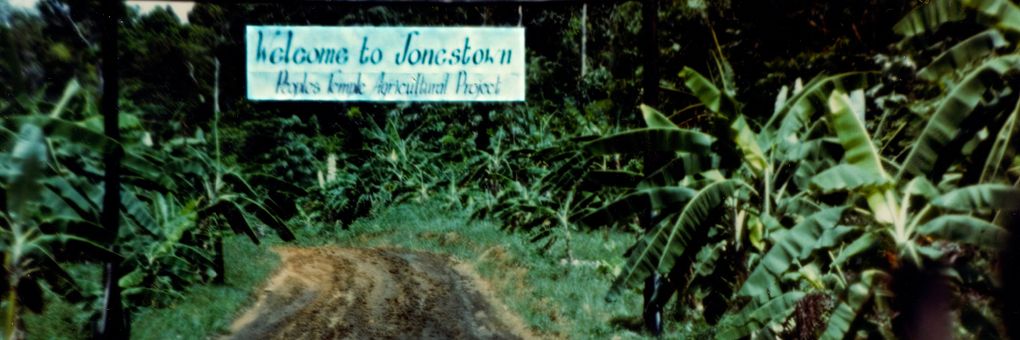Over 900 people died in 1978 at Jonestown, which became a symbol of “doomsday” cults. Charismatic and autocratic, Jim Jones preached equality but believed only in himself; every independent mind became an existential threat.
◊
There was much in the early public presence of the Peoples Temple doomsday cult that some people would have found very appealing. Pastor Jim Jones preached a gospel of racial equality and social justice. He founded communes wherever he set up satellite branches of the “mother church.” And he preached that mainstream Christianity wasn’t teaching the truth about God or His plan for equality for all.
Only privately did Jones admit to his atheism and his communist beliefs.
Jones was pro-gay, though his rationale was as twisted as his drug-damaged psyche. Equally twisted was his early history as a strange, neglected boy in rural Indiana. Given the monster he became, his sad childhood does not inspire pity. Instead, the story confirms our darkest fears about wayward children: Some kids, like Jeffrey Dahmer for one benighted example, transform their ghastly upbringings into truly evil compulsions unleashed into society as they become adults.
For more on Jim Jones and the Peoples Temple, check out the MagellanTV documentary Jonestown: Paradise Lost.
The Beginnings of a Manipulative Psychopath
Jim Jones’s childhood was a study in pathos. He was denied almost everything a normal child takes for granted: food, clothing, affection. His family, living in a shack without plumbing or electricity, failed at farming, and they were often so desperate for food that Jim was sent out to nearby fields and woods to forage for whatever sustenance he could find.
When Jones was 14, his mother finally divorced his abusive, alcoholic father. This only caused their situation to become more dire. Jim found refuge in churches, where a strong father figure led services that might end with the boy receiving food or cast-off clothes.
“Nobody gave me any love, any understanding. . . . Always was alone.” —Jim Jones, 1977
Those services were where Jones originally picked up the idea of becoming a preacher. It was the only image of stability he perceived in his world. He dreamed of leading services and even started to practice by picking up roadkill and interring the remains with “religious” burials involving neighborhood children. This odd habit did not endear him to others; rather it estranged him from his neighbors and classmates, who avoided the dirt-poor, death-and-religion-obsessed child.
Nonetheless, with daily support and shelter from the local library, he persevered and developed into a high-achieving student. Living with his mother, who only sparingly and resentfully worked outside the home, Jones took a job at a local hospital while still in high school. Here, he met his future wife, Marceline, who would see him to his bitter, murderous end. Jones was 18 when they married; Marceline, 22.
Early Years of a Fraudulent Ministry
Without any ministerial training, Jones bluffed his way into a position as youth pastor at a Methodist church. But Jones had another secret. Over the prior years, he had read voluminously about political and religious philosophies and settled on one as the source of his own beliefs: communism. He had accepted atheism into his heart and Marxism as his guiding principle, even attending meetings of the Communist Party, USA. So why had he chosen to go into the ministry? According to Jones himself, he felt a duty as a communist to “infiltrate” the church for his own ends.
Life as a Methodist youth pastor didn’t fulfill his aims, and he didn’t last there long. He was looking for new fields to “infiltrate,” and he was attracted to the theatrical “faith healings” he witnessed in Pentecostal congregations. He learned the tricks of phony faith healings, using chicken gizzards to make it appear he was removing tumors from sick people (or confederates he’d planted in the audience).
He even added an old carny trick of “telepathy,” employing investigators who’d interviewed attendees to gather the information he would spring on them, knowing, for example, their names, Social Security numbers, and of course, their personal desires for the minister to pray over. Jones used these tricks to draw worshipers to the church he founded in 1955. Called Wings of Healing, this little Indianapolis church was the precursor to his coming Peoples Temple.
The Peoples Temple Captures the Zeitgeist of the 1960s
In addition to his Marxist-inspired egalitarianism, Jones was evidently sincere about the need for racial integration in churches and throughout society. At least, he integrated his church, discovering that questionable practices like faith healing could attract numbers of Black parishioners whose experiences with similar traditions in segregated Black churches made them feel comfortable in their new, integrated denomination.
Jones also claimed the gift of divine prophecy and declared in 1961 that he had envisioned Chicago being destroyed in a nuclear holocaust, and that deadly radiation would reach Indianapolis. He set about finding a new location for his church.
After years of searching for a place that would survive nuclear annihilation, he picked rural northern California, near the small town of Ukiah. He asked his congregation, numbering in the hundreds, to follow him there to settle in and wait out the destruction of the coming war. His projected paranoia seemed to work, as 140 church members willingly moved from Indianapolis to Ukiah.
His prophecy, pinned to July 1967 as the date of the disaster, didn’t pan out, but that didn’t seem to bother the faithful, or Jones. Instead, he was busy hatching plans to expand his congregation. He moved the community again in 1971, this time to San Francisco. From there, he continued his travels across the state, eventually forming an assembly in Los Angeles in 1972 and additional “satellite” congregations in Bakersfield, Fresno, and other metropolitan areas throughout California.
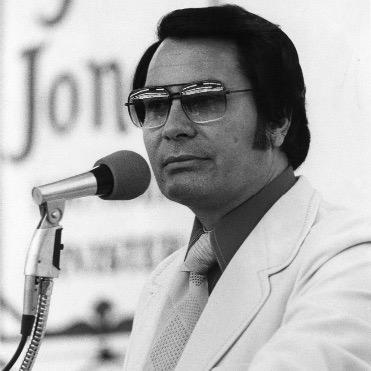
Jim Jones, 1976 (Source: SDSU Repository)
Force, Control, and Sexual Coercion: The Scandal of the Peoples Temple
Life within the church became more regimented as it grew. Jones preached that his followers should form communes, donate all their income to the Temple, and live together in racially integrated, egalitarian communities. This was not unusual for San Francisco, which was in the vanguard of communal living in the late 1960s during the hippie movement.
As Jones grew more powerful, his megalomania ballooned, augmented by his increasing use of amphetamines for energy and barbiturates to help him sleep. He started referring to himself as the “savior” of his people, who were taught to refer to Jones as “Father” or “Dad.”
Though he never lived communally himself, preferring an apartment in the city, he held sway over more than a dozen group homes, primarily centered in San Francisco’s Fillmore district, not far from Haight-Ashbury, where bands such as Jefferson Airplane and the Grateful Dead also established communes.
Jones preached a peculiar “sexual freedom” among church members. He used his position of power as leverage to have sex with scores of his followers, both female and male. Jones may have been bisexual, but we know at least that his desire for sex with men was a constant. In December 1973, he was arrested in the men’s room of a late-night theater in Los Angeles for exposing himself and propositioning an undercover agent.
Jones professed that all men are latent homosexuals – except him. But his mission was to help men express their latency by having sex with him. This seemed to work with more than a few male Temple members.
Beyond taking all his parishioners’ money to operate the church and live a comfortable lifestyle, Jones started dabbling in local politics, supporting progressive principles such as social justice, civil rights, and other causes of the era. His ability to demand fealty from Temple members did not go unnoticed. Politicians saw how he could turn out a thousand or more of his faithful to canvass neighborhoods and get out the vote to support politicians and issues he favored.
George Moscone, Willie Brown, and Harvey Milk were among the city’s liberal wing that supported the Peoples Temple. When Moscone became mayor, with the support of Jones and his followers, he rewarded Jones with the chair of San Francisco’s Housing Authority, which set policy for public housing amid other duties.
An Unwelcome Light of Negative Publicity Exposes Jones and the Peoples Temple
In 1977, after hearing stories of misdoings at Peoples Temple, including physical beatings, forced humiliation, withholding of food, blackmailing members to keep them in line, and other signs of Jones’s growing power and paranoia, journalist Marshall Kilduff started to prepare an article on the Temple. By this time seen as a local political kingmaker, Jones was alarmed at the potential for damage to his exalted position within his fiefdom.
His power was so great that the editor of the publication to which Kilduff sold his exposé, New West magazine, took the unusual step of calling Jones and reading him the entire article before publication in July 1977. Jones took immediate action, instructing Temple members to move with him to the South American country of Guyana to get away from the prying eyes of American media and lawmakers. In 1973, Jones had used Temple money to purchase 1,800 acres of land hacked out of the tropical Guyanese forest. He then sent 50 of his most devoted flock to set up an “agricultural project” to demonstrate that the Temple could thrive in his so-called “socialist paradise.”
It didn’t work.
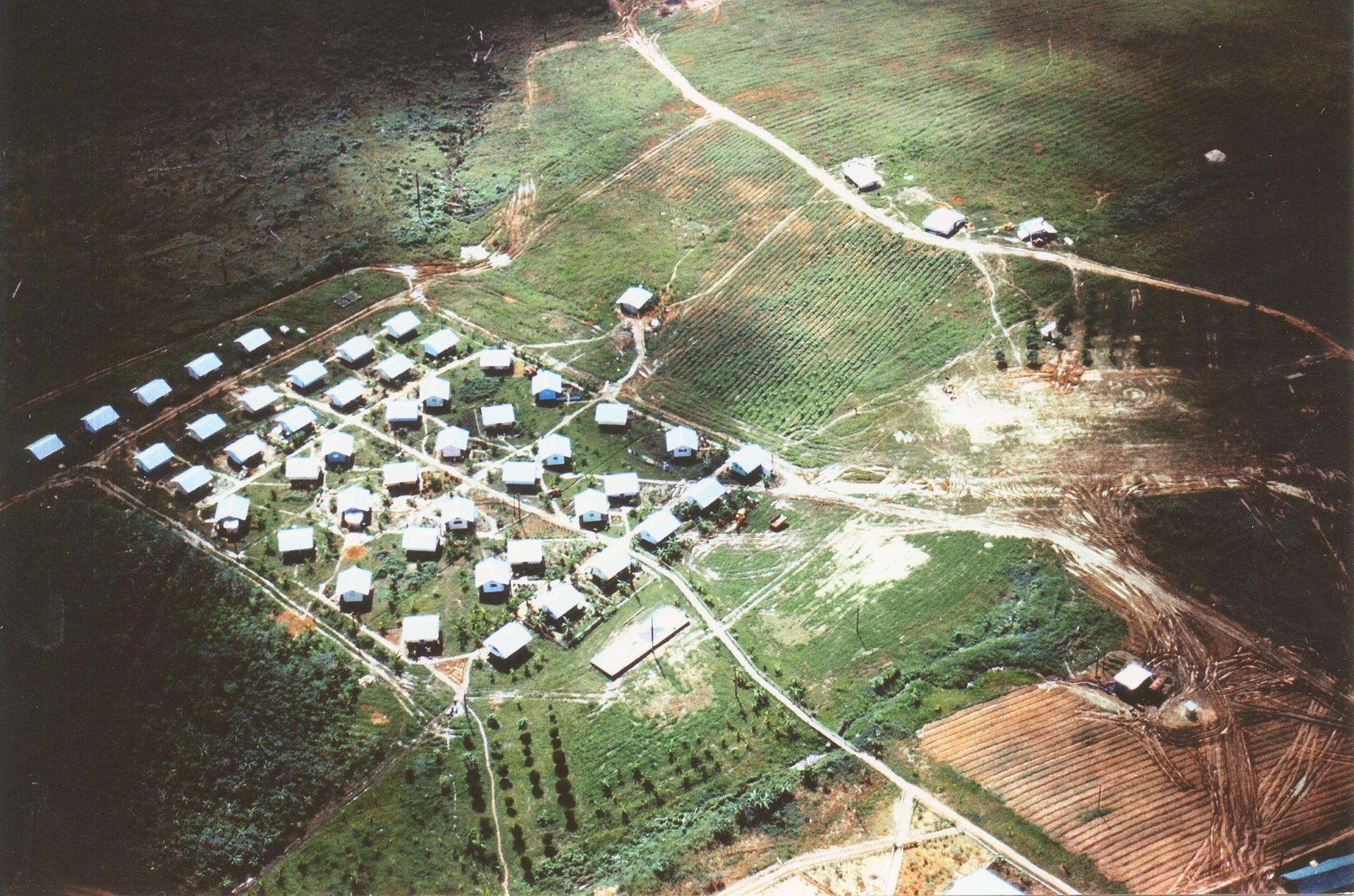
Aerial view of Jonestown settlement, Guyana (Source: Wikimedia)
The Temple’s ‘White Night’ Arrives: Mass Murder and Suicide
Scrutiny of the Temple and its practices grew after the New West article, and other news outlets began interviewing ex-members. As Jones received reports about these stories in the press, his paranoia grew exponentially. He began to view the Jonestown compound as constantly under siege, and he tested the loyalty of his followers by staging what he termed, “White Nights.”
During these evening meetings, which every member was compelled to attend, Jones would rant and fume about all the Temple’s enemies. The American media was one; the U.S. government was another. He ran end-of-days scenarios in which Jonestown residents were forced to choose among four options:
- flee to the Soviet Union;
- escape into the jungle;
- stand and fight; or
- commit “revolutionary suicide.”
Despite how few attendees would vote for so-called “revolutionary suicide,” he often made everyone, from babies to adults, drink a fruit-flavored beverage that he said would bring about a peaceful death. When members realized it was only a drill, everyone could relax until the next Jones address was carried over the settlement’s loudspeaker system.
Back in the States, former members lobbied government representatives to investigate conditions at the compound. Finally, one California congressman, Leo Ryan, listened to his constituents’ stories of abuse and more. He decided to take a delegation to Jonestown, including his staff and local and national media crews. The results were beyond tragic.
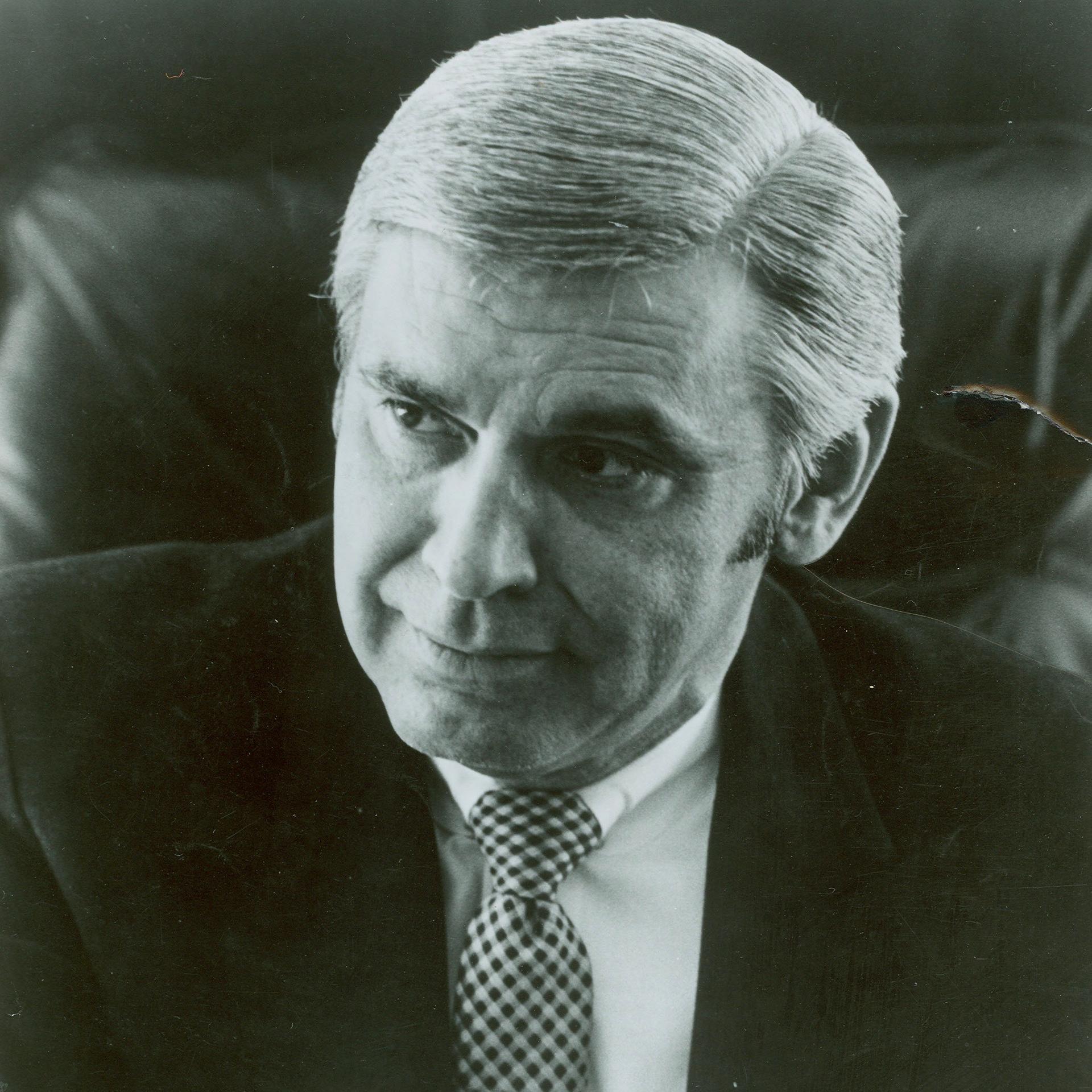
U.S. Congressman Leo Ryan was murdered by Jones’s armed guards on November 18, 1978. (Source: Wikimedia)
On November 18, 1978, Ryan and his party arrived to inspect the camp and interview Temple members. A handful volunteered to leave and return to the U.S. with the congressman, but most professed they were happy and wished to remain.
Ryan was attacked with a knife while completing his stay. Though he was uninjured, the congressman chose to leave hastily with the defectors. But once his party returned to the airstrip where their planes were waiting, an armed convoy raced up and opened fire. Ryan was repeatedly struck by bullets and died on the runway. A total of five of the departees were murdered there, and more were injured.
At the Temple, Jones informed his followers the congressman was dead – and the ‘End Times’ had come. He called for an ultimate White Night and, with the camp’s physician as his accomplice, began the forced distribution of syringes and cups of a powdered beverage called Fla-Vor-Aid laced with heavy doses of cyanide and barbiturates. Jones harangued Temple members to dose the children first, then dose themselves.

Case of Fla-Vor-Aid discovered at the site of the Jonestown mass murder/suicide. (Source: Wikimedia)
Those who questioned this decision were threatened with shooting by armed guards. Nonetheless, some attempted to flee into the jungle, a rational decision amid the madness. Approximately 30 escaped, but many more were captured and injected with the lethal concoction.
Death was not immediate and not painless. On a 44-minute tape recorded during the death march, Jones is heard shouting for his hundreds of victims to stop crying and screaming and to quiet the babies. “Die with dignity,” he proclaimed. As for himself, he never touched the grape Fla-Vor-Aid; he either shot himself in the head or directed one of his lieutenants to do it for him.
Overall, 918 people died that day. More than 70 percent were African Americans, and 276 were children. To call this a mass suicide is a misnomer. Indeed, some died willingly, but many were coerced.
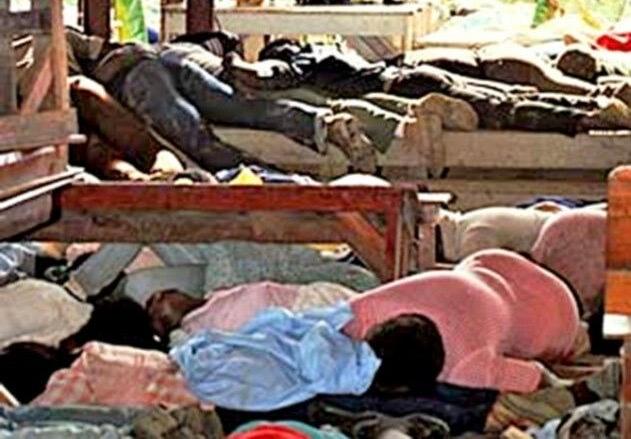
Bodies of Jonestown residents poisoned by cyanide, 1978 (Source: Alexis Nichole, via Pinterest)
Jim Jones and the Quintessence of Evil
Jones had it within his vast power over thousands of followers to lead a ministry for good – or evil. His paranoia and megalomania led him straight into darkness. Covering his authoritarian scheme with a patina of social good, he hoodwinked multitudes. But his true message, that he was the Messiah and his word was law, led too many down a path of no return.
Today, we may wonder how these people relinquished their free will to a psychopathic despot, but there will always be a path for crazed tyrants to gain power. Whether they wrap themselves in a flag of dubious patriotism or crown themselves the new Messiah, their age-old message is clear: There’s no room for free thinking.
Ω
Kevin Martin is Senior Writer for MagellanTV. He writes on various topics, including outer space, the fine arts, and modern history. He has had a long career as a journalist and communications specialist with nonprofit and for-profit organizations. He resides in Glendale, California.
Title Image: Welcome sign to the Peoples Temple Agricultural Project, known better as Jonestown. (Image credit: The Jonestown Institute, via Wikimedia)

